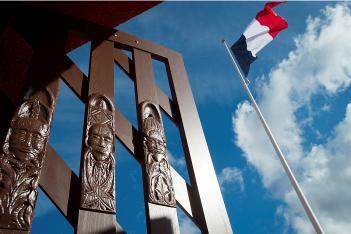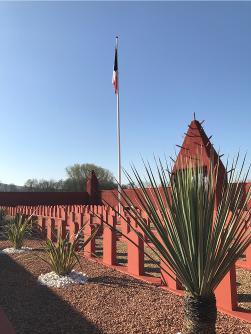African masks in a cemetery in the Rhône valley
In mid-June 1940, as the Germans advanced rapidly southwards, threatening the rearguard of the Army of the Alps, pockets of resistance were organised to contain them.

Des masques africains dans une nécropole rhodanienne
© Guillaume Pichard
Among the troops deployed north of Lyon was the 25th Regiment of Senegalese Tirailleurs (RTS), who received orders to “resist with no thought of retreat”. On 19 and 20 June, they were involved in heavy fighting against elements of the 3rd SS Panzer Division “Totenkopf”. Overwhelmed, exhausted and low on ammunition, some fifty survivors surrendered to the attackers.
The Senegalese captives were then ordered to disperse across the fields. From the road, the Germans opened fire with machine guns, mowing down 48 of them, before crushing their bodies with two tanks.
These summary executions of black prisoners were systematic and the SS “Totenkopf” Division left a trail of other massacres in its wake on its passage through the region: 18 were executed at Lentilly, 13 at Éveux, and in the Lyon neighbourhood of Vaise, 27 Senegalese tirailleurs were lined up against a wall, machine-gunned down, then left on public display for two days.
In no time a unique military cemetery was built to lay to rest the bodies of the dead soldiers. Built on the initiative of Jean Marchiani, a First World War veteran and general secretary of the Departmental Office for War-wounded, Veterans, Victims of War and Wards of the State, the cemetery was designed “to imitate the tatas, sacred enclosed spaces where warriors killed in battle are buried in West Africa”.
The structure is rectangular and its long sides, 40 metres in length, are oriented north-south. The red-ochre perimeter walls are 2.8 metres high and each corner pillar has a pyramid-shaped top spiked with wooden stakes.

Des masques africains dans une nécropole rhodanienne
@DR
Access is via a gate nearly 3 metres wide, designed by Abbé Boisard, head of a cabinetmaking school in Villeurbanne. The solid-oak uprights are carved with eight different, stylised masks, representing fetishes watching over the sleep of the dead.
The cemetery was officially opened on 8 November 1942, three days before the invasion of the Free Zone by the Germans. A company of the 153rd Infantry Regiment paid its respects. The prayers for the dead were recited by Father Aupiais, a Catholic chaplain, Pastor Vernier and Si Aouane Ben Khalifat, imam of the Paris mosque, before children sprinkled soil brought from Dakar over the graves. Representatives of the government were present, among the veterans. At liberation, on 24 September 1944, the Lyon authorities paid a fresh tribute to the Senegalese tirailleurs who died for France.
The “Senegalese Tata” was made a national cemetery in 1966. Owned by the State, it comes under the responsibility of the Ministry of the Armed Forces (Directorate for Heritage, Remembrance and Archives – DPMA). It is maintained by the National Office for Veterans and Victims of War (ONAC-VG), on the DPMA’s behalf.
As part of the Ministry of the Armed Forces’ multi-annual remembrance-site restoration programme, the cemetery was completely restored in 2018, in view of the 2020 commemorations (interior walls, emblems, gravel paths, paintwork and landscaping). The programme also included the installation of a historical information panel.
The cemetery, the only one of its kind in France, receives African personalities and officials on visits to France.
- The president of Burkina Faso, Blaise Compaoré, visited it on 19 October 2004.
- On 20 March 2005, it was the turn of Senegalese president Abdoulaye Wade, who laid a floral wreath and presented the commune with a bronze statuette symbolising the brotherhood in arms of the metropolitan French and African soldiers.
In addition, every year ceremonies are held here:
- On the third Sunday of June, the Lyon Association of Colonial Troops and Marine Troops pays tribute to the tirailleurs, in a ceremony attended by civilian and military officials;
- Meanwhile, on 11 November every year, Lyon’s African community traditionally gathers at the Senegalese Tata to remember the African tirailleurs killed in action.
Finally, the site is frequently visited by large numbers of pilgrims and tourists (nearly 1,500 visitors every year).
Find out more:
- A feature on the African soldiers who served France
- A presentation and other photos of the Senegalese Tata in Chasselay
- A series of resources on the 80th anniversary of 1940

